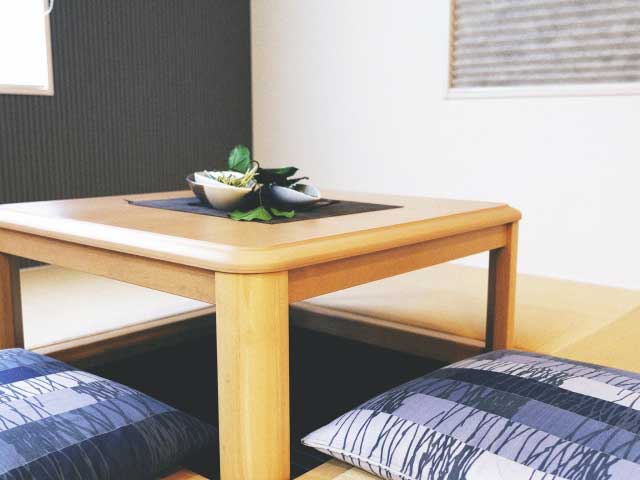Kotatsu Heated Tables
Kotatsu are Japanese low tables with a heater underneath and covered with a thick quilt.
Japanese Culture: Kotatsu こたつ
Mark Brazil
 Hori-gotatsu
Hori-gotatsu
Traditional Japanese architecture can be described as uncomfortably ambient, at least from a western perspective. The temperature indoors mirrors that outside, leaving the interior of a Japanese house unpleasantly hot in summer and unbearably cold in winter.
While staying in a mountain village in the European Alps, or in northern Norway or Finland, it is not uncommon to struggle to open the window because not merely double, but triple glazing has been employed for winter insulation. Under similar conditions in a mountain village in Japan in winter, it is not uncommon to slide aside the paper covered shoji of the minshuku to find no outer layer of glass at all, let alone double glazing.
Snow falling outside is only prevented from reaching the paper of the screens by the greatly overhanging eaves and by a loose screen of reeds leaning against the eaves. Yet to dismiss Japanese rooms (washitsu) as uncomfortable is to ignore certain important features of behaviour and furniture.
It is typical in a Japanese household to take a deep, hot bath early enough in the evening for that to last and qualify as 'central' heating. After the bath a padded, or quilted cotton jacket (hanten) though not entirely fashionable is de rigeur, as the wadded cotton lining is an excellent insulator and helps retain the core heat provided by the earlier bath. Then one crouches and slides one's legs beneath a kotatsu and all is well and warm in the world.
This style of heating is far removed from the western concept of central heating, and unlike central heating it does not go along with loft insulation, cavity wall insulation and double-glazing. Kotatsu-style heating goes along with hot baths, hanten and futon warmed by hot water bottle, as a way of keeping warm.
The kotatsu is a low table frame, over which a thick quilt is spread, over that a table top is placed, and under which there is some form of heating. In the more distant past this was some kind of charcoal burner, while now it is more typically an electrical element or heat lamp that produces a low, but generous enough heat to keep the feet and legs warm.
 As autumn comes around kotatsu appear in the furniture sections of department stores. Here the table top overlies a festive quilt, which hides the table frame beneath
As autumn comes around kotatsu appear in the furniture sections of department stores. Here the table top overlies a festive quilt, which hides the table frame beneath
 Underneath the table frame is an electrical heating element, the warmth from which is trapped beneath the quilt ready to warm feet, legs and hands
Underneath the table frame is an electrical heating element, the warmth from which is trapped beneath the quilt ready to warm feet, legs and hands
Two types of kotatsu are in common usage in Japan, in both restaurants and homes. The first sits directly on the floor, the second (hori-gotatsu) sits over a pit or recess in the floor, providing a space of about 40 cm or so in which to dangle one's legs, more like sitting on a chair.
The kotatsu is a cosy place to sit and read, or to chat and to munch mikan (small Japanese oranges), or even to nap. The rising warmth of the kotatsu permeates through clothing and is retained by the table's quilt and by the quilting of the hanten, making this an inexpensive way to keep warm in a room that may have been constructed entirely without insulation.
 Kotatsu, the only furniture in a typical minshuku room in Shirakawa-go, Honshu, in winter
Kotatsu, the only furniture in a typical minshuku room in Shirakawa-go, Honshu, in winter
Related Japan Articles
Japan House & Home
Japan Seasons
Japan Weather
Japan's Natural History
